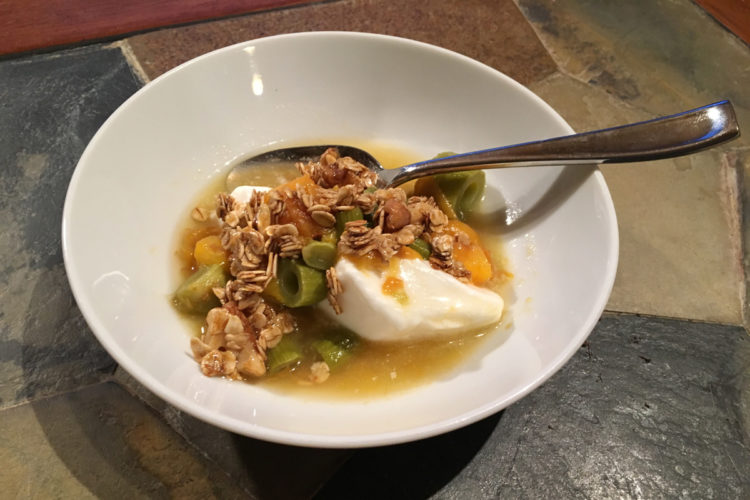
I’m breaking my fast this morning with stewed Japanese knotweed and peaches over Greek yogurt, topped with homemade granola. It’s a surprisingly nice combination—and beyond that, it’s very simple to make. I used last year’s harvest—which I had chopped and stewed with sugar and stuffed in the freezer—cooked together with yummy, slightly tart, also-frozen peaches from my friend’s tree.
I’ve been foraging and experimenting with wild food recipes for many years now, and some of the ideas I come up with are quite complicated and special. But I am not a chef. I am a home cook charged with the daily task of feeding myself and my better half—and in the end, it’s the meals I make over and over again that define which wild plants I use most often. I think stewed Japanese knotweed and peaches is destined to become one of them.
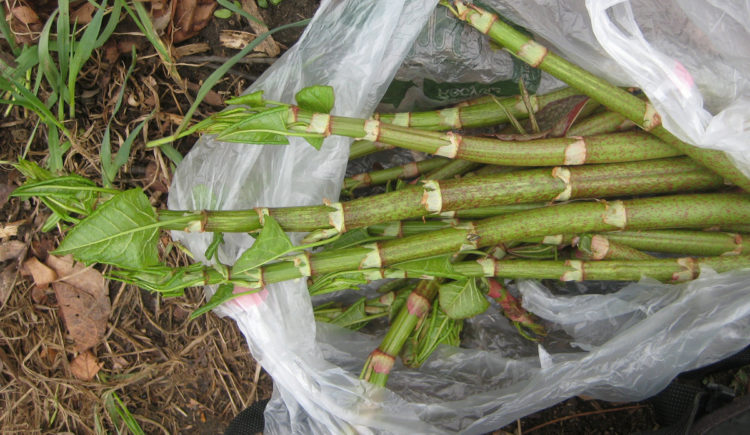
Japanese knotweed (Polygonum cuspidatum syn. Fallopia japonica) is a tall, invasive perennial that forms huge colonies in some regions. Whenever I travel to the Northeast I make a habit of spotting the arching, rust-colored stalks from a previous year’s growth from the car window, always on the lookout for less-trodden spots where the young stalks of spring might be foraged without threat of pollution by car exhaust or herbicides.
The young spears look a bit like bamboo in the way they are jointed, and they are green, flecked with varying amounts of red. Later, heart-shaped leaves (some more indented at the base than others) unfurl on P. cuspidatum and its close, edible relatives, but this is past the point when the stalks are ideal to harvest. Tender spears or branch tips should be collected when (and where on the stalk) they are young, fast-growing, and break easily. For more information on harvesting and preparing Japanese knotweed, check out this video by Ellen Zachos of Backyard Forager.
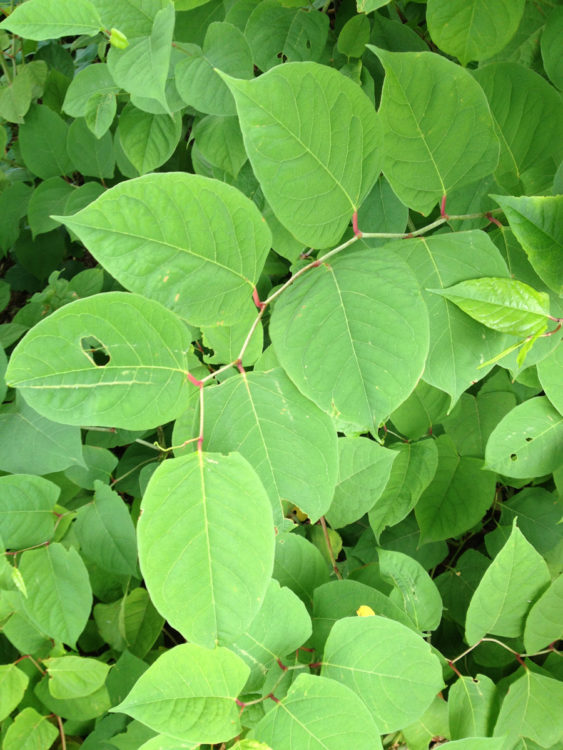
Parts of Japanese knotweed are high in resveratrol—a polyphenol found in red wine and grape skins shown to have cancer-preventative, cardio-protective, and lifespan-improving effects in lab and animal models, with growing evidence of its human benefits emerging from clinical trials in recent years (Smoglia et. al., 2011). Since the underground rhizomes have a high concentration, it stands to reason that the shoots may also be a good source of resveratrol, although if Samuel Thayer could not find a chemical analyses of those, it must not yet exist (Incredible Wild Edibles, 2017).
I enjoy the tart flavor and crunch of young Japanese knotweed stalks sliced raw into thick rings on salad, and many folks use them as a rhubarb substitute in baking. (Next time I gather a fresh batch I look forward to trying Leda Meredith’s Japanese knotweed bars). Some people peel them before eating—Sam says it makes every Japanese knotweed preparation better to remove the bitter skins—but I’ll admit to some laziness on this front. Perhaps that is why I haven’t always loved Japanese knotweed. If I’m not careful, there’s an aftertaste of what my husband describes as “swamp-like,” or reminiscent of his grandmother’s basement. But the peaches balanced that surprisingly nicely—so I have been eagerly eating it the last couple mornings for breakfast, and I can now foresee other Japanese knotweed/fruit combinations in our future, giving me more reason to collect in quantity and put it up for future use.
Japanese knotweed and its edible relatives, giant knotweed (P. sachalinensis) and the hybrid Bohemian knotweed (P. x. bohemicum), are List A noxious weeds in Colorado. They can grow from tiny segments of the fresh plant, so the discarded bits should be disposed of carefully—completely dried out or boiled before throwing on the compost heap—or else they are likely to take root and take over.
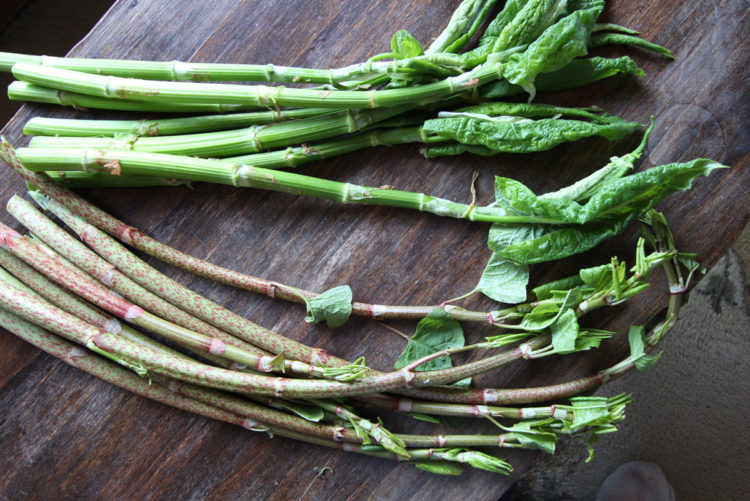
Japanese knotweed is not as pernicious here in Colorado as it is in other regions, but colonies can definitely be found at lower elevations. My friend and foraging companion Butter showed me a few in the Denver area a couple years ago, and now they stick out to me like sore, reddish thumbs, the tall, arching stalks of past years’ growth standing out from the willows, often along waterways in well-traveled public locations. It’s a perennial, so once you’ve identified a population, it simply becomes a matter of returning at the right time in early spring to catch them as the shoots push their way forth.
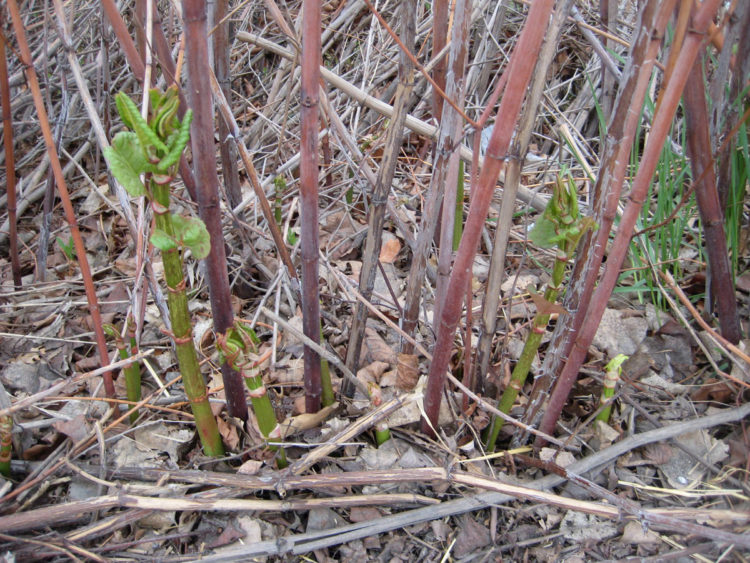
You are probably not allowed to pick Japanese knotweed from public open spaces due to blanket no-pick regulations, but as a List A species, their eradication is mandated—so you decide if you want to take the risk!
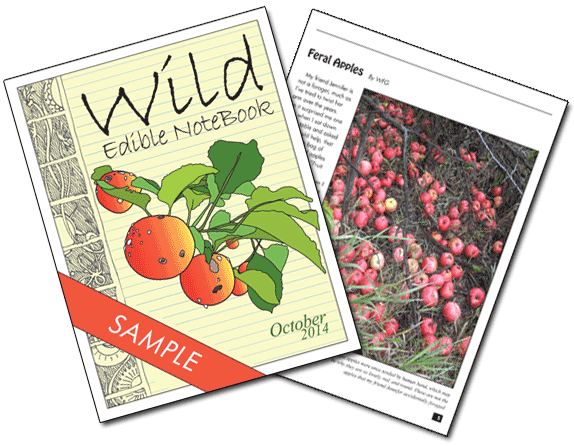
Ive been following Stephen Harrod Buhner for a while, and after my wife Lori contracted Lyme Disease 2 years ago, I bought his book on Lyme. And that is when Japanese Knoweed came onto my radar. And now a way to eat it too. Very cool.
Thanks for what you are doing
Hi Andrew, I wish you and your wife the best. Chronic Lyme is awful. Members of my family have also been battling an infection-caused autoimmune condition similar to (and sometimes a co-infection of) Lyme–a chronic bacterial infection of Chlamydia pneumoniae. I hope Buhner’s protocol works for you. Most sincerely, erica
When is the best to harvest rhizomes for medicine ? Early spring late spring!??? Fall after flowering ???? Thanks
Hi Donna, this is not my area of expertise. If anyone else is reading this who has an answer, please share!